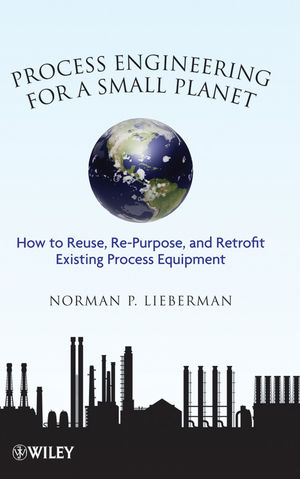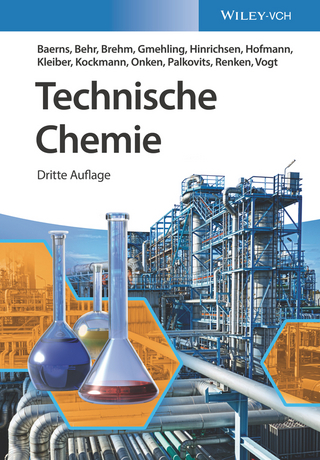
Process Engineering for a Small Planet
John Wiley & Sons Inc (Verlag)
978-0-470-58794-2 (ISBN)
Methods for more planet-friendly process engineering Our earth is just one big, complex Process Facility with limited air, water, and mineral resources. It responds to a number of process variables—among them, humanity and the environmental effects of our carbon consumption. What can professionals in the Hydrocarbon Process Industry do to retard environmental degradation? Rather than looking to exotic technology for solutions, Process Engineering for a Small Planet details ready-at-hand methods that the process engineer can employ to help combat the environmental crisis.
Drawing from the author's professional experience working with petroleum refineries petroleum refineries, petrochemical plants, and natural gas wells, this handbook explains how to operate and retrofit process facilities to:
Reuse existing process equipment
Save energy
Reduce greenhouse gas emissions
Expand plant capacity without installing new equipment
Reduce corrosion and equipment failures
Covering topics from expanding fractionator and compressor capacity and vacuum tower heater expansion to minimizing process water consumption and increasing centrifugal pump capacity, Process Engineering for a Small Planet offers big ideas for saving our small planet.
NORMAN P. LIEBERMAN is an independent process design engineer and field troubleshooter. His clients are refineries and petrochemical plants. He is well known in the process industry for his seminar "Troubleshooting Process Operations," which has been presented to over 16,000 engineers and plant operators.
Foreword xv
Preface xvii
Introduction: Turning of the Tide 1
1. Expanding Fractionator and Compressor Capacity 3
Reuse of Existing Fractionator
Changing Tray Deck Panels
Alternates to New Compressor
Keeping Compressor Rotor Clean
Calculating Liquid Injection Rates to Compressor
2. Vacuum Tower Heater Expansion 17
Entrainment Velocity Limitations
Missing Tray Deck Manways
Heater Draft Limitation
Improving Ejector Performance
Velocity Steam in Heater Passes
3. Natural-Draft-Fired Heaters 27
Control Excess Air
O2 and Combustible Analyzers
Improving Air–Fuel Mixing
Convective Section Air Leaks
Air Preheater Leaks
Indirect Air Preheat
4. Crude Pre-Flash Towers 37
Pre-Flash Tower Flooding
Energy Saving with Pre-Flash Towers
Capacity Benefits
Pre-Flash Tower External Reflux
5. Amine Regeneration and Sulfur Recovery 47
Amine Capacity Expansion
Sulfur Plant Capacity Expansion
Rich Amine Flash Drum Design
Cascaded Seal Legs
Sulfur Recovery from Sour Water Stripper Off-Gas
Acid Gas of High CO2 Content
Sulfur Plant Oxygen Enrichment
6. Treating and Drying Hydrocarbons 59
Jet Fuel Treating
Salt Dryer Operation
Water-Washing Sodium Naphthanates from Jet Fuel
Pipe Distributor Design
Treating Sour Naphtha
Converting Mercaptans to Disulfides
7. Minimizing Process Water Consumption 71
Two-Stage Wastewater Stripper
Steam Condensate Recovery
Condensate Drum Balance Line Location
Water Hammer
Measuring Condensate Recovery
Cooling Tower Cycles of Concentration
8. Incremental Expansion Design Concept: Reprocessing Waste Lube Oil 79
Reprocessing Waste Lube Oil
Vacuum Tower Design
Wash Oil Grid Coking
Vapor Horn Design in Vacuum Towers
Stripping Tray Efficiency
Precondenser Fouling
Pump NPSH Limit in Vacuum Service
Exchanger Fouling in Waste Oil Service
Transfer-Line Sonic Velocity
9. Improving Fractionation Efficiency in Complex Fractionators 91
Pre-Flash Tower Concept
Intermediate Reflux
Stripping Tray Efficiency
Maximizing Diesel Recovery from Crude
Picket Weirs
Adjusting Pump-arounds
Pressure Optimization
10. Increasing Centrifugal Pump Capacity and Efficiency 103
Hydraulic Limitations
Worn Impeller-to-Case Clearances
Impeller Wear Ring
Upgrading Impeller Size
Marginal Cavitation
Viscosity Effects on Efficiency
NPSH Limited Condition
11. Eliminating Process Control Valves Using Variable-Speed Drivers 113
Frequency Control of Motors
Eliminating Control Valves on Pump Discharge
Direct Speed Control of Steam Turbine
Variable-Speed Compressors
Spill-backs Waste Energy
Calculating Incentive for Variable-Speed Drivers
Floating Tower Pressure Control
12. Expanding Refrigeration Capacity 123
Centrifugal Compressor Head vs. Flow Curve
Calculating Compression Work
Horsepower vs. Suction Pressure Limited
Effect of Increasing Suction Pressure
Reducing Refrigerant Condenser Fouling
Effect of Noncondensibles
Condensate Backup in Condenser
13. Oversizing Equipment Pitfalls 135
Amine H2 S Scrubber
Optimizing Number of Trays in Absorbers
Consequences of Overdesign
Use of Demister in Knockout Drum
Low Demister Velocity Promotes Mist Entrainment
14. Optimizing Use of Steam Pressure to Minimize Consumption of Energy 145
Preserving the Potential of Steam to Do Work
Power Recovery from Steam to a Reboiler
Use of the Mollier Diagram
Cogeneration Plants
Extracting Work from Reboiler Steam Using
Existing Equipment
Understanding Thermodynamics of Flowing Steam
Steam Turbine Efficiency Checklist
15. Expanding Compressor Capacity and Efficiency 157
Reciprocating Compressors
Pulsation Dampener Plates
Adjustable Head-End Unloaders
Natural Gas Engines
Axial Compressor
Rotor Fouling of Axial Air Compressor
Centrifugal Compressors
Cleaning Centrifugal Compressor Rotor
16. Vapor–Liquid Separator Entrainment Problems 171
Effect of Foam on Indicated Liquid Levels
Hydrogen-Heavy Gas Oil Separtors
Foam Induced Carry-Over
Enhancing De-Entrainment Rates
Vapor Distribution Aids De-Entrainment
17. Retrofitting Shell-and-Tube Heat Exchangers for Greater Efficiency 179
Running Slops Without Fouling
Floating Suction in Charge Tanks
Exchanger Online Spalling
Effect of Feed Interruptions
Tube Velocity and Surface Roughness
Shell-Side Seal Strips
Cooling High-Viscosity Fluids
Expanding Water Cooler Capacity
Hydrocarbon Losses to Cooling Towers
18. Reducing Sulfur and Hydrocarbon Emissions 189
Sulfur Plant Waste Heat Boiler Modifications
Hydrocarbon Leaks in Seawater Cooling Systems
Incinerator Back-Fire in Sulfur Plant Main
Reaction Furnace
Loss of Draft Due to Air Leaks
Global Emissions in Perspective
19. Hydrocarbon Leaks to the Environment 201
Measuring Leaks Through Valves
Fixing Leaking Valves On-Stream
Detecting Leaking Relief Valves
On-Stream Repair of Leaking Relief Valves
Measuring Flows in Flare Lines
Leaks into Cooling Water
Air Cooler Leaks
Valve Stem Packing
Leaking Pump Mechanical Seal and Improper Use of Seal Flush
Fixing Weld Leaks On-Stream
20. Composition-Induced Flooding in Packed Towers: FCU Fractionator Expansion 209
Fluid Cracking Unit Fractionator Expansion
Flooding of Slurry Oil P/A Sections
FCU Fractionator Vapor Line Quench
Multipump Piping Stress Analysis
Perception vs. Reality in Process Design
21. Maintenance for Longer Run Lengths 219
Sulfuric Acid Regeneration
Importance of Reactor Insulation
On-Stream Piping Repairs
Preserving Pump Mechanical Seals
Concept of Avoiding Unit Shutdowns
22. Instrument Malfunctions 229
Control Valve Loss Due to Instrument Air Pressure Signal
Stuck Flow Control Valve Stem
Mislocated Liquid-Level Tap
Reducing Load to Vacuum System by Correcting False Level Indication
23. Summary Checklist for Reuse of Process Equipment 237
Fired Heaters
Heat Exchangers
Fin-Fan Air Coolers
Distillation Tower Trays
Vapor–Liquid Separators
Centrifugal Pumps
Fixed-Bed Reactors
Electric Motors
Gas and Steam Turbines
Reciprocating and Centrifugal Compressors
Air Blowers
Water–Hydrocarbon Separators
Overcoming Utility System Limits
24. Water–Hydrocarbon Separation: Corrosive Effects of Water 245
Water–Oil Separators
Corrosive Elements from Cracking Plants
Water Traps in Strippers
Current CO2 Levels
Environmental Overview
Appendix: Solar Power Potential 257
Index 259
| Erscheint lt. Verlag | 3.9.2010 |
|---|---|
| Verlagsort | New York |
| Sprache | englisch |
| Maße | 158 x 236 mm |
| Gewicht | 567 g |
| Themenwelt | Naturwissenschaften ► Chemie ► Technische Chemie |
| Technik | |
| ISBN-10 | 0-470-58794-6 / 0470587946 |
| ISBN-13 | 978-0-470-58794-2 / 9780470587942 |
| Zustand | Neuware |
| Haben Sie eine Frage zum Produkt? |
aus dem Bereich


